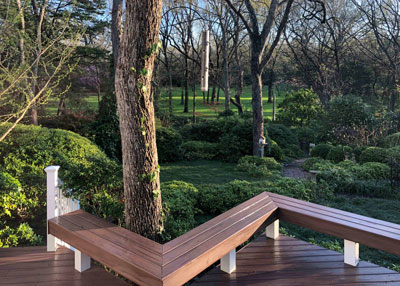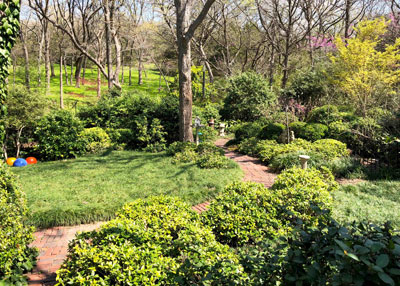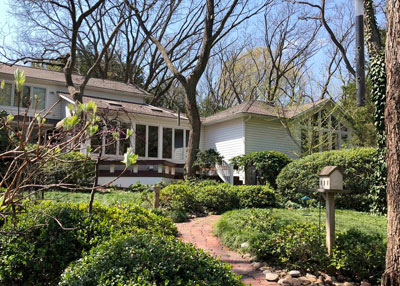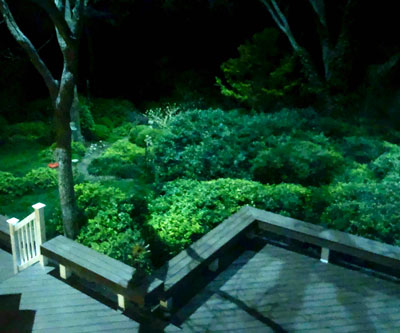From the Sperry Landscape: March 28, 2019, Part II
I keep a spiral notebook on my broadcast desk as I do my radio programs. I’ve done that since I went on the air in 1978. I like to look back to see what questions were on the minds of my listeners, and the Number One Question of all time is, “Neil, what can I do when my grass won’t grow in the shade?”
My family lives on the floor of a mature pecan forest. Those trees in my photo from this past Monday morning are starting to bud out, and soon we won’t see the sun again until November. Yet the landscape plants that you see here are going to do very well – just as they’ve done for the past 25 years since I planted them.
But we’ve been here 42 years. The first 17 years we had redcedars and other native trees coming right up to our windows. We could reach out and touch them. We were one with nature. However, those redcedars became naked due to the shade. Their needles were 25 feet up in the air and our view out the windows grew less than inspiring. I decided to open it all up, and suddenly we had this vista before us. I had to call on my plant friends to come to my rescue, and these are the ones that stood alongside me.

The Sperry backyard as photographed this past Monday following a rainstorm overnight Sunday. Click image for larger view.
Let me introduce them to you as best I can…
• Ginkgo off to the left is just budding out. I love ginkgos. We have two. I use them as accent trees for their dramatic branching and brilliant golden yellow fall foliage. This one made an excellent staging station for gold finches and other birds waiting their turns at our feeders this winter. (We went through about 10 pounds of sunflower seeds daily. You can see a larger feeder hanging in the distance over and to the right of the small white church. We had four other feeders of various types.)
• Straight above the white post, those are old dwarf Burford hollies. They’re now 5 to 6 ft. tall, showing that even dwarf plants do grow.
• The somewhat rounded, squatty globes just behind the benches are Carissa hollies. You’ll see 7 or 8 more Carissas (lighter green) beneath the little white church and to the right of the walk just behind the short concrete pedestal. You see Giant Liriope growing to the right of the concrete pedestal.
• Behind the Carissa hollies, on the right side of the photo, you’ll see some dark green and decidedly rounded globes about 3 ft. tall. Those are Japanese boxwoods (Green Beauty). It should be noted that I shear many of my shrubs one time late each winter, then let them grow naturally the ensuing growing season. That includes these boxwoods and the hollies I’ve been describing.
• The taller shrubs in the more distant shadows – those in the 4- to 6-ft. range – include a few Needlepoint hollies, also Mary Nell, Robin, Cardinal, and Oakleaf hollies. I have a couple of kinds of regular yaupons in that mix, and a really tall Nellie R. Stevens holly. There is a large lusterleaf holly in the right rear, but you have to know that it’s there.
• The tall plant with sun shining off many of its leaves is an old-fashioned Chinese photinia. I actually have six or eight of them that I’ve planted in various parts of our landscape for screening. I love that old plant so much more than the disease-ridden redtip photinias that no one should plant. But it, too, may be prone to Entomosporium leaf spot. Perhaps my plants’ remote location will buy them some time.
• You can see redbuds scattered throughout the woods. Most are natives that have come up as volunteers. I also have four or five types of viburnums just starting to leaf out. They’ll be in bloom in the next several weeks, most notably my eastern snowballs. And you can easily see the Oakleaf hydrangeas just leafing out on the right edge of the photo about the middle from top to bottom. They’ll be in full white bloom in five or six weeks.
Three other plant types that must be noted…
• Eastern redcedars: If you look to the horizon you’ll see a row of evergreens that appear to be about 25 ft. tall. Those are eastern redcedar junipers (Juniperus virginiana) that I transplanted as 12-inch seedlings 24 years ago. I paid a neighbor, a farmer, $1 per tree, to let us dig them out of his fields. He thought we were crazy, but we planted them in a zig-zag pattern 18 to 22 ft. apart. I watered them by hand for their first two years, and you see the results. They’ve been on their own ever since.
• Annual ryegrass: That’s the grass you see growing across the creek (which you can’t see). I plant it from seed each October to cut down on erosion from the otherwise bare ground. It also serves to prove my point: Overseeding with ryegrass does not waste water as some cities contend. I watered that hillside in October to get the seed started. I know I watered it one time, and it might have been twice in that same first week, but I have never watered it since. It stands as its own proof that ryegrass does not equate to wasting of water. Personal opinion – those rules should be relaxed.
• Mondograss: Because all Texas turfgrasses require 5-6 hours of direct daily sunlight in summer (or more) to survive and thrive, it was immediately obvious to me that I would need a shade-tolerant groundcover for our backyard. This is regular mondograss, also known as monkeygrass or lilyturf. It grows to 5 to 6 inches tall. I do not mow it, and it does not attract snakes or rodents any more than other aspects of living would do. These areas in our yard are too big for dwarf mondograss. I’ve also used Persian ivy, but poor drainage in one wet spring caused it to fail. I have purple wintercreeper euonymus in some of my beds, but it’s harder to blow pecan leaves out of those beds since wintercreeper has runners. Mondograss is simply my choice. I propagate my own by dividing clumps at any time of the year.

Walking out across the deck gives you a slightly different perspective of our backyard. It also gives you a look at our walk that I laid in 1995 out of antique street paver bricks from a North Texas city. I did about 10 feet an evening. These were made somewhere around 1900, and these are heavy pavers!

This is a seldom-seen view of our home. It’s our landscape turned inside-out.

Photo: From our bedroom window upstairs just two nights ago, the work of Lentz Landscape Lighting is inspiring even when the pecans are still bare.
And finally, we enjoy this part of our landscape at night just as well. Lentz Landscape Lighting did a stunning job of illuminating it 24 years ago, and they came back and retrofit it with low-energy lamps a couple of years back. We love the look at all seasons.
People ask if I’d ever consider opening up our grounds for a tour of our landscape, and the answer for many reasons is “probably not.” But this is hopefully a close approximation. I hope you’ve enjoyed it.
